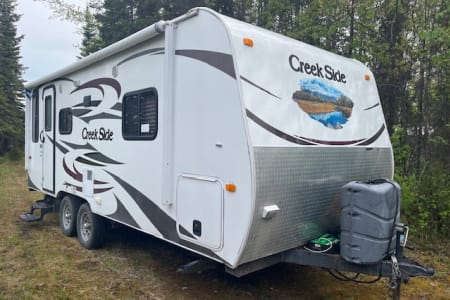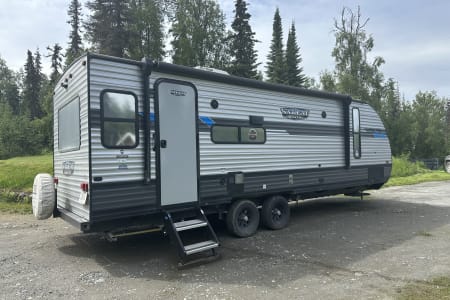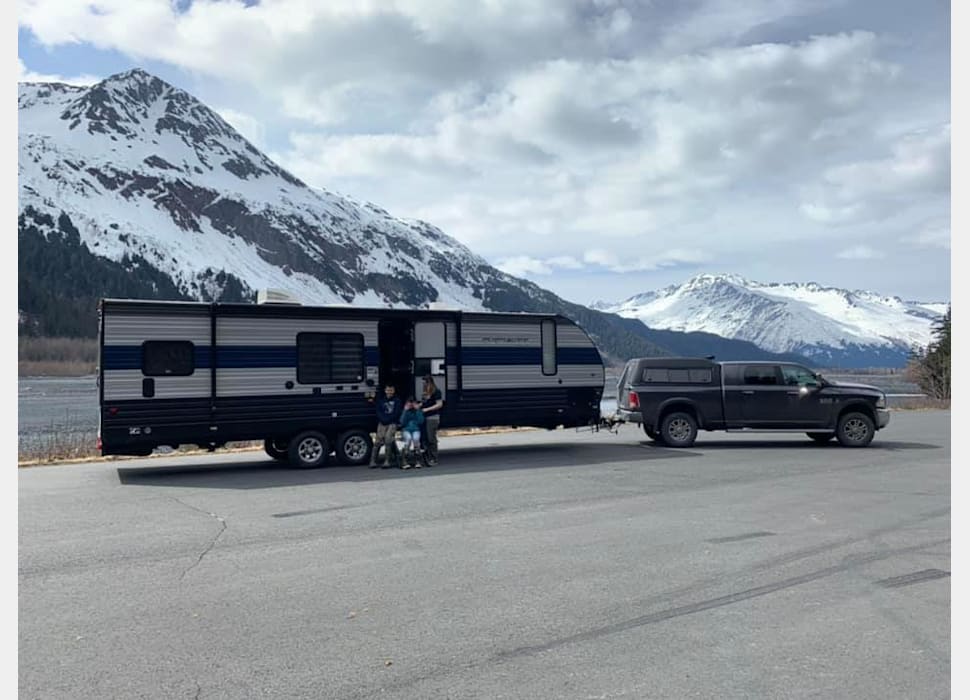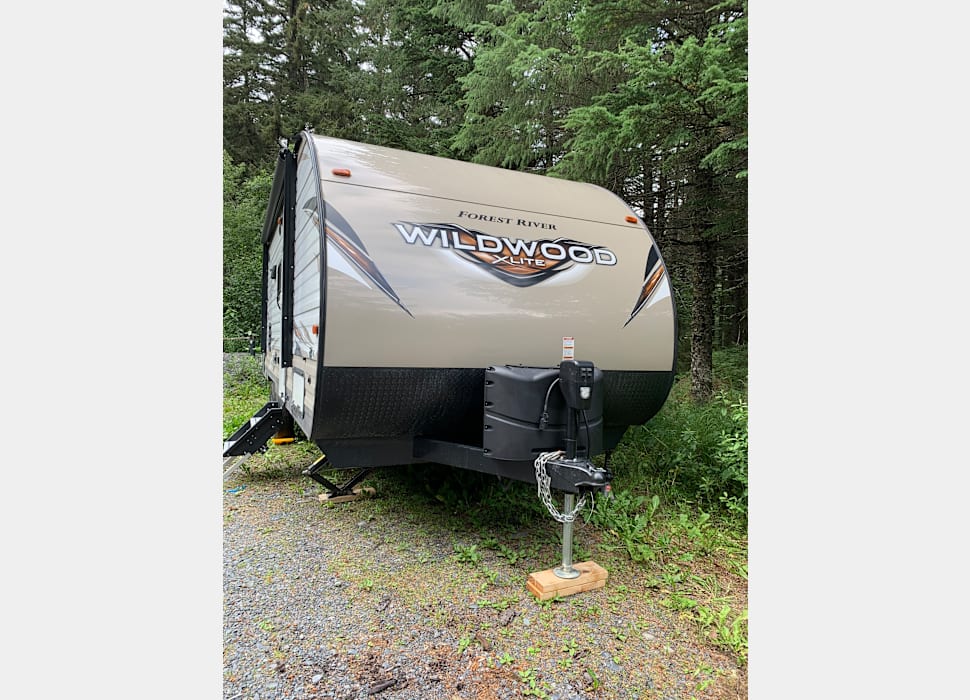Kenai Fjords National Park Alaska (AK) RV Rentals
RV Rentals Dates
RV Rentals near Kenai Fjords National Park?
Introduction
Kenai Fjords National Park is a gem of Alaska, offering breathtaking landscapes, rich history, and a plethora of outdoor activities. It is an ideal spot for RV camping, providing a unique opportunity to immerse yourself in nature while enjoying the comforts of home on wheels.
The park holds great historical and cultural significance. It is home to the indigenous Alutiiq people, who have inhabited the area for thousands of years and have a deep connection to the land and its resources. Exploring the park allows visitors to learn about the indigenous culture and the history of the early settlers who ventured into this rugged wilderness.
RVThereYet.com is an RV rental company, offering a diverse fleet of motorhomes, including Class A, Class B, and Class C Rentals, Travel, Trailers, and Motorhomes for unforgettable adventures in scenic RV parks and campsites in Kenai Fjords National Park. Ensure early reservations for camper rentals at Kenai Fjords National Park.
Transportation
-
Driving/Transportation
When visiting Kenai Fjords National Park, private vehicle travel is a convenient option for exploring the park. Visitors can access the park from different entrances, including the Exit Glacier area and the town of Seward.
To reach the Exit Glacier area, visitors can take the Seward Highway (AK-9) south from Anchorage. The park entrance is located approximately 12 miles north of Seward. From there, a well-maintained road leads to the Exit Glacier Visitor Center, where visitors can learn about the park’s glaciers and embark on hiking trails.
Seward, a charming coastal town, serves as a gateway to Kenai Fjords National Park. Visitors can drive to Seward and explore the park by taking a boat tour from the town’s harbor. These tours offer a chance to witness the park’s stunning fjords and glaciers up close.
It’s important to note that there are restrictions on rig sizes within the park. The maximum length for RVs or trailers is 40 feet, and the maximum combined length for a vehicle and trailer is 60 feet. It’s recommended to check the park’s regulations and plan accordingly if you’re traveling with a larger rig.
Private vehicle travel provides the flexibility to explore Kenai Fjords National Park at your own pace and access different areas of the park. Whether you choose to visit the Exit Glacier area or start your journey from Seward, you’re in for a memorable adventure in this breathtaking Alaskan destination.
-
Parking area
Kenai Fjords National Park offers designated RV parking areas throughout the park making it convenient for RV travelers to explore the park’s attractions. However overnight parking outside of designated campsites is not permitted. It is highly recommended to camp with an RV in the park’s designated campsites and utilize alternative transportation methods such as boat tours or hiking to explore the park’s stunning fjords and glaciers. This allows for a more immersive and enjoyable experience while respecting the park’s regulations.
-
Public Transportation
Kenai Fjords National Park does not offer public transportation options such as shuttle buses or walking paths for getting around the park. However there are guided boat tours available from the town of Seward which provide transportation and a guided experience to explore the park’s fjords and glaciers. Additionally there are hiking trails within the park that can be accessed on foot for those who prefer to explore by walking.
Top Campsites in Kenai Fjords National Park
-
Reservations camping
Seward KOA
Located just outside of Kenai Fjords National Park Seward KOA is a highly popular campsite offering a range of amenities and activities. It features spacious RV sites with full hookups tent sites and cozy cabins. The campsite is pet-friendly and offers amenities such as Wi-Fi laundry facilities and a playground. Activities in the area include fishing hiking and wildlife viewing. Seward KOA is open from May to September and permits RVs and trailers up to 70 feet in length.
Miller’s Landing Campground
Situated in Lowell Point near Seward Miller’s Landing Campground is a scenic and serene camping spot. It offers both RV and tent sites some of which have stunning ocean views. The campground provides amenities such as restrooms showers and a camp store. Activities include kayaking fishing and beachcombing. Miller’s Landing Campground is pet-friendly and open from May to September. RVs and trailers up to 40 feet in length are permitted.
Stoney Creek RV Park
Located in Seward Stoney Creek RV Park is a popular choice for RV campers. It offers spacious RV sites with full hookups picnic tables and fire pits. The park provides amenities such as laundry facilities restrooms and Wi-Fi. Nearby activities include hiking fishing and wildlife viewing. Stoney Creek RV Park is pet-friendly and open from May to September. RVs and trailers up to 40 feet in length are permitted.
Resurrection River Campground
Situated along the Resurrection River Resurrection River Campground is a picturesque camping spot offering a peaceful and natural setting. It features both RV and tent sites with amenities including restrooms picnic tables and fire rings. Activities in the area include fishing hiking and birdwatching. Resurrection River Campground is pet-friendly and open from May to September. RVs and trailers up to 40 feet in length are permitted.
These four campsites/KOA near Kenai Fjords National Park offer a range of options for RV and tent camping. From full hookups and ocean views to serene riverfront locations each campsite provides a unique experience for visitors. Whether you’re looking for a pet-friendly campground or convenient amenities these campsites are sure to enhance your adventure in the stunning surroundings of Kenai Fjords National Park.
-
First-come first-served
Exit Glacier Campground
Located near the Exit Glacier area this first-come-first-served campground offers 12 campsites. It is open from May to September providing visitors with the opportunity to experience the beauty of the park during the summer months. The campground can accommodate RVs and trailers up to 32 feet in length. It offers basic amenities such as pit toilets and picnic tables. Pets are allowed but must be kept on a leash.
Primrose Campground
Situated in a scenic location along the Kenai River Primrose Campground offers 12 first-come-first-served campsites. It is open from May to September providing a wonderful camping experience during the summer season. The campground can accommodate RVs and trailers up to 32 feet in length. Amenities include pit toilets picnic tables and fire rings. Pets are allowed but must be kept on a leash.
Stoney Creek Campground
Located in the heart of Kenai Fjords National Park Stoney Creek Campground offers 12 first-come-first-served campsites. It is open from May to September allowing visitors to enjoy the park’s beauty during the summer months. The campground can accommodate RVs and trailers up to 32 feet in length. Amenities include pit toilets picnic tables and fire rings. Pets are allowed but must be kept on a leash.
These first-come-first-served campgrounds in Kenai Fjords National Park provide an opportunity for spontaneous camping adventures. With a limited number of campsites it’s recommended to arrive early to secure a spot. Whether you choose to camp near Exit Glacier along the Kenai River or in the heart of the park these campgrounds offer a chance to immerse yourself in the natural beauty of the area and create lasting memories.
-
Alternate camping
If the campsites inside Kenai Fjords National Park are full there are alternative camping options available nearby that RV renters can consider. Here are a couple of options
Private Campgrounds
There are several private campgrounds in the vicinity of Kenai Fjords National Park that offer RV camping. These campgrounds often provide a range of amenities such as full hookups showers laundry facilities and Wi-Fi. Some popular private campgrounds near the park include the Seward KOA and Stoney Creek RV Park. These private campgrounds offer a convenient and comfortable camping experience for RV renters who prefer additional amenities and services.
Backcountry Camping
For those seeking a more adventurous camping experience backcountry camping is an option near Kenai Fjords National Park. The Chugach National Forest which surrounds the park offers opportunities for dispersed camping in designated areas. RV renters can find secluded spots amidst the wilderness and enjoy a more remote camping experience. It’s important to note that backcountry camping requires careful planning as there are no designated campsites or amenities. Visitors should follow Leave No Trace principles and obtain any necessary permits or information from the local ranger station.
These alternative camping options provide flexibility for RV renters who are unable to secure a campsite inside Kenai Fjords National Park. Whether you choose to stay at a private campground with additional amenities or venture into the backcountry for a more rustic experience there are options available to suit different preferences and camping styles.
-
General activities
Boat Tours
One of the most popular activities in Kenai Fjords National Park is taking a boat tour to explore the stunning fjords and glaciers. These tours offer a chance to witness the park’s breathtaking landscapes and spot wildlife such as whales sea lions and puffins. Boat tours depart from the town of Seward providing a convenient starting point for your adventure into the park’s pristine waters.
Hiking
Kenai Fjords National Park boasts a variety of hiking trails that cater to different skill levels. The Harding Icefield Trail is a favorite among hikers offering a challenging but rewarding trek to a panoramic view of the icefield. For a shorter hike the Exit Glacier Trail provides an up-close look at the park’s glaciers. These trails showcase the park’s natural beauty and offer opportunities to spot wildlife along the way.
Fishing
With its abundant rivers lakes and coastline Kenai Fjords National Park is a paradise for fishing enthusiasts. Anglers can try their luck at catching salmon trout and halibut in the park’s pristine waters. Whether you prefer fly fishing spin casting or deep-sea fishing there are plenty of opportunities to reel in a memorable catch.
Wildlife Viewing
Kenai Fjords National Park is home to a diverse array of wildlife making it a prime destination for wildlife enthusiasts. Visitors can spot bears moose mountain goats and a variety of bird species in their natural habitats. The park’s coastal areas are particularly rich in marine life offering opportunities to see whales sea otters and seals.
Kayaking
Exploring the park’s fjords and coastline by kayak is a popular activity for outdoor enthusiasts. Paddle through calm waters marvel at the towering glaciers and immerse yourself in the tranquility of the surroundings. Kayaking allows for a closer connection with nature and a unique perspective of the park’s stunning landscapes.
These recreational activities in Kenai Fjords National Park attract outdoorsy RV campers seeking adventure and natural beauty. Whether you choose to embark on a boat tour hike through the wilderness try your hand at fishing spot wildlife or kayak along the coast there is no shortage of exciting experiences to be had in this remarkable national park.
-
Alternative activities
Sightseeing Cruises
For RV campers who prefer a more relaxed approach to exploring the park sightseeing cruises are a popular choice. These cruises offer a leisurely way to experience the stunning beauty of Kenai Fjords National Park. Sit back and enjoy the scenic views as you glide through the park’s fjords spot wildlife and marvel at the towering glaciers. These cruises depart from the town of Seward providing a convenient starting point for your adventure.
Wildlife Watching
Kenai Fjords National Park is a haven for wildlife making it an ideal destination for nature enthusiasts. RV campers can enjoy leisurely walks along the park’s trails or find a comfortable spot to observe the diverse array of wildlife. Keep an eye out for bears moose eagles and seals. The park’s coastal areas are particularly rich in marine life offering opportunities to spot whales sea otters and seabirds.
Photography
Kenai Fjords National Park offers countless opportunities for Instagram-worthy photos. From the majestic glaciers to the serene fjords and lush forests the park’s landscapes provide a stunning backdrop for photography. Capture the vibrant wildflowers in bloom the reflections on the calm waters or the rugged beauty of the icefields. Whether you’re a professional photographer or simply enjoy taking snapshots Kenai Fjords National Park will inspire you to capture its natural beauty.
Visitor Centers
The park’s visitor centers are not only informative but also provide an opportunity to learn about the park’s history geology and wildlife. RV campers can visit the Exit Glacier Visitor Center or the Alaska SeaLife Center in Seward to gain a deeper understanding of the park and its unique ecosystem. These centers offer exhibits interactive displays and knowledgeable staff who can answer questions and provide insights into the park’s natural wonders.
Scenic Drives
For those who prefer to experience the beauty of the park from the comfort of their RV scenic drives are a great option. The Seward Highway which leads to the park offers breathtaking views of mountains forests and coastal scenery. Take your time to enjoy the vistas stop at overlooks and soak in the natural splendor of the area.
These alternative recreational activities in Kenai Fjords National Park cater to RV campers who prefer a more relaxed and leisurely approach to exploring the park’s beauty. Whether you choose to embark on a sightseeing cruise observe wildlife capture stunning photographs visit visitor centers or enjoy scenic drives there are plenty of options to make your visit to Kenai Fjords National Park a memorable one.
Season-specific experiences in Kenai Fjords National Park
-
Spring activities
Wildflower Viewing
Spring brings a burst of color to Kenai Fjords National Park as wildflowers bloom across the landscape. Take a leisurely stroll along the park’s trails and marvel at the vibrant display of nature’s beauty. From lupines to Indian paintbrushes the park is adorned with a variety of wildflowers that will leave you in awe. The Exit Glacier area and the trails surrounding it are particularly popular for wildflower viewing.
Historical Landmarks
Explore the rich history of Kenai Fjords National Park by visiting historical landmarks such as the Resurrection River Historic District. This district contains remnants of early homesteads and cabins that tell the story of the park’s early settlers. Take a step back in time and imagine what life was like in this rugged wilderness. The Resurrection River Historic District is located near the park’s entrance and offers a glimpse into the past.
Birdwatching
Spring is a prime time for birdwatching in Kenai Fjords National Park. As migratory birds return to the area bird enthusiasts can spot a wide variety of species. Look out for bald eagles soaring through the sky colorful songbirds perched on branches and seabirds nesting along the coast. The park’s coastal areas such as Resurrection Bay are particularly popular for birdwatching.
Photography
Springtime in Kenai Fjords National Park provides ample opportunities for photography enthusiasts. Capture the beauty of the park’s landscapes as they come alive with vibrant colors and new growth. From the snow-capped peaks to the blooming wildflowers there are countless subjects to capture. The Exit Glacier area and the coastal regions offer stunning backdrops for your photographs.
Whale Watching
Spring is a fantastic time for whale watching in Kenai Fjords National Park. As the waters of the park come alive with marine life RV campers can embark on boat tours to witness these majestic creatures up close. Keep an eye out for humpback whales breaching the surface feeding and playing in the park’s fjords. Boat tours departing from Seward offer the best opportunities for whale watching.
These springtime recreational activities in Kenai Fjords National Park offer a unique and memorable experience for RV campers. Whether you choose to witness the vibrant wildflowers explore the park’s historical landmarks engage in birdwatching capture stunning photographs or go whale watching there are plenty of opportunities to enjoy the beauty of the park during the spring season.
-
Summer activities
Glacier and Fjord Boat Tours
Summer is the prime time to embark on boat tours to explore the awe-inspiring glaciers and fjords of Kenai Fjords National Park. Cruise through the park’s icy waters and witness the immense beauty of towering glaciers calving into the sea. These boat tours provide an up-close and personal experience with the park’s most iconic features offering stunning photo opportunities and a chance to spot wildlife such as seals sea lions and whales.
Hiking and Backpacking
With the snow melted and the trails accessible summer is the perfect season for hiking and backpacking adventures in Kenai Fjords National Park. Lace up your hiking boots and explore the park’s diverse terrain from lush forests to alpine meadows. Popular trails include the Harding Icefield Trail which rewards hikers with panoramic views of the icefield and the Exit Glacier Trail which offers a closer look at the park’s glaciers.
Wildlife Viewing
Summer is a fantastic time to observe the abundant wildlife in Kenai Fjords National Park. Keep your eyes peeled for bears moose mountain goats and a variety of bird species as you explore the park’s trails and coastal areas. Take a wildlife viewing cruise or join a guided tour to increase your chances of spotting these magnificent creatures in their natural habitats.
Fishing
Summer offers excellent fishing opportunities in Kenai Fjords National Park. Cast your line into the park’s rivers lakes and coastal waters and try your luck at catching salmon trout and halibut. Whether you’re an experienced angler or a beginner the park’s pristine waters provide a serene setting for a day of fishing.
Kayaking and Canoeing
Explore the park’s fjords and coastline at your own pace by kayaking or canoeing during the summer months. Paddle through calm waters marvel at the towering glaciers and immerse yourself in the tranquility of the surroundings. Kayaking and canoeing allow for a closer connection with nature and provide opportunities to spot wildlife and explore hidden coves and beaches.
These summertime recreational activities in Kenai Fjords National Park offer endless opportunities for adventure and exploration. Whether you choose to embark on a boat tour hike through the wilderness spot wildlife cast your line for fishing or paddle along the coast the park’s natural wonders await your discovery during the summer season.
-
Fall activities
Fall Foliage Viewing
As the summer transitions into fall Kenai Fjords National Park transforms into a stunning display of autumn colors. Take a leisurely hike along the park’s trails and witness the vibrant hues of red orange and gold as the leaves change. The Exit Glacier area and the Harding Icefield Trail offer picturesque views of the fall foliage against the backdrop of glaciers and mountains.
Wildlife Photography
Fall is a fantastic time for wildlife photography in Kenai Fjords National Park. As animals prepare for the approaching winter they become more active and visible. Capture stunning images of bears foraging for food moose in rutting season and migratory birds preparing for their journey south. The park’s diverse ecosystems provide ample opportunities to photograph the wildlife in their natural habitats.
Bird Migration
Fall is a critical time for bird migration and Kenai Fjords National Park is a stopover for many species. Birdwatchers can witness the spectacle of thousands of birds as they gather and prepare for their long journey south. The park’s coastal areas such as Resurrection Bay are particularly popular for birdwatching during the fall season.
Quiet Hiking
Fall brings a sense of tranquility to Kenai Fjords National Park as visitor numbers decrease. Take advantage of the peaceful atmosphere and enjoy quiet hikes along the park’s trails. Explore the rugged beauty of the park’s landscapes witness the changing seasons and immerse yourself in the serenity of nature.
Wildlife Spotting
Fall is a prime time for wildlife spotting in Kenai Fjords National Park. As animals prepare for winter they become more active and visible. Keep an eye out for bears feeding on salmon moose browsing on fall foliage and eagles soaring through the sky. The park’s diverse habitats provide ample opportunities to observe and photograph wildlife during this season.
These fall recreational activities in Kenai Fjords National Park offer a unique and tranquil experience for RV campers. Whether you choose to witness the vibrant fall foliage capture stunning wildlife photographs observe bird migration enjoy quiet hikes or spot wildlife in their natural habitats the park’s beauty awaits your exploration during the fall season.
-
Winter activities
Snowshoeing and Cross-Country Skiing
As winter blankets Kenai Fjords National Park in snow it offers a winter wonderland for snowshoeing and cross-country skiing enthusiasts. Strap on your snowshoes or skis and venture out into the serene landscape. Explore the park’s trails and witness the beauty of snow-covered forests and frozen lakes. The peacefulness of winter adds a whole new dimension to the park’s scenery.
Wildlife Tracking
Winter provides a unique opportunity to track wildlife in Kenai Fjords National Park. With the snow on the ground it becomes easier to spot tracks and signs left by animals. Follow the footprints of animals such as moose foxes and rabbits and gain insights into their behaviors and movements during the winter months.
Photography
Winter in Kenai Fjords National Park offers a picturesque setting for photography enthusiasts. Capture the park’s landscapes adorned with a blanket of snow the icy blue hues of glaciers and the contrast of wildlife against the winter backdrop. The park’s scenic trails and frozen waterways provide endless opportunities for capturing stunning winter photographs.
Winter Wildlife Viewing
While some animals hibernate or migrate during winter Kenai Fjords National Park still offers opportunities to spot wildlife. Keep an eye out for animals such as moose foxes and birds that are adapted to the cold weather. The park’s coastal areas may also provide sightings of seals and sea lions resting on ice floes.
Winter Camping
For adventurous RV campers winter camping in Kenai Fjords National Park can be a thrilling experience. With proper preparation and equipment you can enjoy the solitude and beauty of the park’s winter landscape. Set up camp in designated areas and wake up to stunning snowy vistas. Be sure to check weather conditions and road closures before embarking on a winter camping trip.
These winter recreational activities in Kenai Fjords National Park offer a unique and serene experience for RV campers. Whether you choose to snowshoe or ski through the snowy trails track wildlife capture stunning winter photographs spot winter wildlife or embark on a winter camping adventure the park’s beauty and tranquility await you during the winter season.













